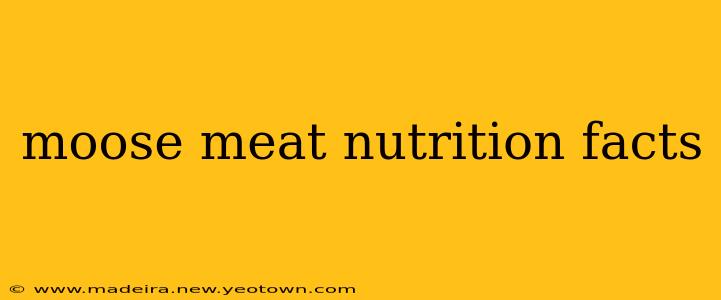The crisp autumn air bites at your cheeks as you stand overlooking the vast Canadian wilderness. The scent of pine needles mixes with the earthy aroma of damp soil. You've just harvested your moose, a magnificent creature that provided sustenance for generations before you. But beyond the thrill of the hunt, lies a bounty of nutritional goodness. Let's delve into the fascinating world of moose meat nutrition.
Moose meat, also known as elk meat in some regions, is a lean, dark red meat prized for its unique flavor and impressive nutritional profile. It's a powerhouse of protein and essential nutrients, making it a highly sought-after food source for both survivalists and health-conscious consumers.
What are the nutritional benefits of moose meat?
Moose meat is low in fat and calories compared to many other red meats. Think of it as a leaner, wilder cousin to beef. But its leanness doesn't compromise on its nutrient density. It’s rich in:
-
High-Quality Protein: Moose meat is an excellent source of complete protein, meaning it contains all nine essential amino acids our bodies need but can't produce on their own. This protein is crucial for building and repairing tissues, supporting immune function, and maintaining overall health.
-
Iron: Boosting your iron intake is vital for preventing anemia and carrying oxygen throughout your body. Moose meat provides a good dose of heme iron, a form more readily absorbed by the body than non-heme iron found in plant-based foods.
-
Zinc: This essential mineral supports immune function, wound healing, and cell growth. Moose meat provides a solid amount of zinc, vital for optimal health.
-
B Vitamins: A variety of B vitamins, such as B12 (crucial for nerve function and red blood cell formation), are abundant in moose meat. These vitamins play crucial roles in energy metabolism and overall well-being.
-
Selenium: This trace mineral acts as a powerful antioxidant, protecting your cells from damage caused by free radicals.
Is moose meat healthy?
Yes, when consumed as part of a balanced diet, moose meat offers numerous health benefits due to its nutrient-rich composition and lower fat content compared to other red meats. However, moderation is key, as with all meats. Too much red meat, regardless of the type, can be associated with health risks.
How does moose meat compare to beef nutritionally?
While both are red meats, moose meat tends to be leaner than most cuts of beef, meaning it generally has lower fat and calorie content. The protein content is comparable, but moose meat often boasts a slightly higher concentration of certain micronutrients like iron and zinc. However, the specific nutritional values can vary depending on the cut of meat and the moose's diet and lifestyle.
What are the potential downsides of eating moose meat?
While generally healthy, there are some potential drawbacks to consider:
-
High in Cholesterol: Like other red meats, moose meat contains cholesterol. Individuals with high cholesterol should consume it in moderation.
-
Purines: Moose meat contains purines, which can be problematic for people with gout.
-
Parasites: Proper handling and cooking are essential to eliminate any potential parasites.
How can I prepare moose meat safely and healthily?
Proper handling and cooking are vital for ensuring the safety and maximizing the nutritional benefits of moose meat. Always ensure the meat is thoroughly cooked to an internal temperature of at least 160°F (71°C) to eliminate any potential parasites or bacteria. Lean cooking methods like grilling, roasting, or stir-frying are ideal for preserving its nutritional value and enhancing its flavor. Experiment with different herbs and spices to elevate the taste!
The rich history and nutritional value of moose meat make it a truly remarkable food source. It offers a unique taste and a wide array of health benefits when consumed responsibly as part of a balanced diet. So, the next time you find yourself in the wild, or simply perusing your local butcher's selection, remember the powerful nutrients packed within this wild delicacy.

